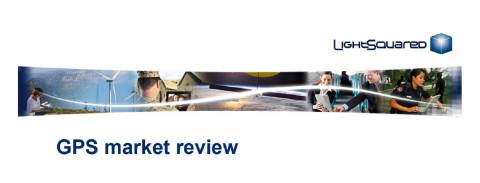A “GPS market review” submitted to the Federal Communications Commission (FCC) this week diverges in methodology and results from a preliminary study of U.S. benefits of the Global Positioning System provided earlier this year to the National Space-Based Positioning, Navigation, and Timing (PNT) Advisory Board.
A “GPS market review” submitted to the Federal Communications Commission (FCC) this week diverges in methodology and results from a preliminary study of U.S. benefits of the Global Positioning System provided earlier this year to the National Space-Based Positioning, Navigation, and Timing (PNT) Advisory Board.
The LightSquared review was presented to FCC staff on Tuesday (July 28, 2015) by Gerard Waldron and Reed Hundt, a former chairman of the Federal Communications Commission (FCC) from 1993 to 1997, both attorneys representing LightSquared in the company’s efforts to revive a proposal to build a terrestrial broadband service in RF bands next to those in which GPS and other GNSS signals are broadcast. The market assessment was reported yesterday as an ex parte filing in the matter of the FCC International Bureau (IB) Docket No. 12-340.
The GPS study prepared for the PNT Advisory Board by Irv Leveson, a consultant to ASCR Federal Research and Technology Solutions, LLC, was described as “conservative” by Leveson because it did not fully cover many GPS applications including those depending on GPS timing information. Nonetheless, its figures far outstripped most of those provided by LightSquared. For instance, the company’s figures for “high-precision” GPS — covering surveying, precision agriculture, and heavy construction — totaled $1.29 billion in 2015, while Leveson’s figure for the same categories in 2013 was $30.3 billion. The total of benefits in Leveson’s study fall into a range of $37.1–$74.8 billion with a midpoint of $55.8 billion.
The divergence in figures arises primarily in the nature of what is being counted. LightSquared’s number appear to only reflect GPS user equipment sales revenue, including calculations of the GPS value in a multi-technology device such as smart phones. Leveson’s figures also include the associated benefits of applying GPS technology, such as increased productivity, innovation and development of new products and markets, scientific research, improved environmental monitoring, time and cost savings, reduced loss of life, injury, and disability.
In addition to the narrow interpretation of the value of GPS, the LightSquared market review presentation was filled with comments that appeared designed to diminish the utility of GPS by pointing out its well-known vulnerability in certain operating environments (such as indoors) and the growing integration of other positioning technologies with GPS to provide more robust PNT solutions. A close reading of those comments, however, suggests they actually acknowledge and reaffirm the centrality of GPS for PNT, as the other technologies such as WiFi or inertial cannot provide a global, absolute positioning capability and serve fundamentally as augmentations to GPS, not replacements.






